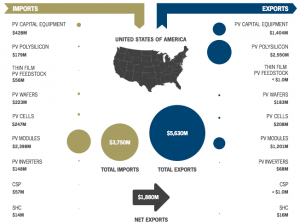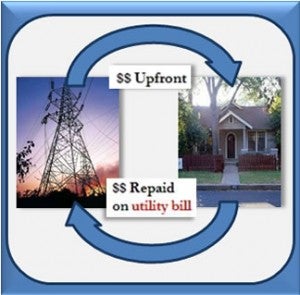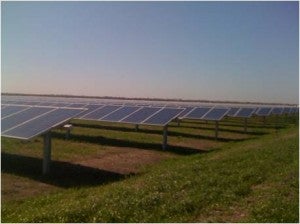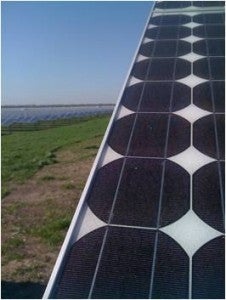Although we have said goodbye to 2011, the advances and achievements in clean energy last year have propelled us into 2012 and will only become more widespread and successful with each passing year. As Steven Lacey at Climate Progress points out in his “Top 10 Clean Energy Stories of 2011”, it was an “odd” year for the clean energy sector, but with great successes. While public demand favors a move to a clean energy economy and environmental sustainability necessitates it, some politicians and their corporate cronies are doing their best to demonize and stall the inevitable leap forward. The reasons why there is obstruction are obvious but it still is a pretty bad calculation and ultimately they are on the wrong side of history. My colleague Colin Meehan responded just a few weeks ago to Grover Norquist’s ill-informed rant against renewable energy. But once we break through the noise and distraction, the reality of what the future holds becomes encouraging. While deniers love to isolate the Solyndra scandal as their defining proof that we must keep and accelerate fossil fuels, it hardly defines the activity and achievements on the ground. In fact, as Lacey articulates, there are much better parameters to judge the new energy revolution:
1. Renewable Power Investments Top Fossil Fuels for First Time
According to Bloomberg New Energy Finance, “electricity from the wind, sun, waves and biomass drew $187 billion last year compared with $157 billion for natural gas, oil and coal.” And they project that renewable energy investments will “double over the next eight years and reach $395 billion per year.”
2. Cost Reductions Make Solar PV Competitive
While complete grid parity will be more of a phased process than a singular result, according to Tom Dinwood, CTO of SunPower, Dan Shugar, CEO of Solaria, and Adam Browning, Executive Director of Vote Solar Initiative, “solar PV is no longer a fringe, cost-prohibitive technology, but rather, a near-commodity that is quickly becoming competitive with nuclear, natural gas, and soon coal.” Solar power is quickly becoming more than cute.
3. Regional Greenhouse Gas Initiative (RGGI) Is A Success
As the aforementioned deniers (in this case the Koch Brothers front group Americans for Prosperity) cried wolf about the RGGI, claiming it would “inflate bills 90% in New Jersey,” the reality of the situation was much different –“RGGI generates greater economic growth in every one of the 10 states that participate than would occur without a carbon price.” This is from a new report, which found that “America’s first mandatory, market-based carbon cap and trade system added $1.6 billion in value to the economies of participating states, set the stage for $1.1 billion in ratepayer savings, and created 16,000 jobs in its first three years of implementation.
4. Pension Funds & Large Companies Invest Big in Energy Efficiency
Further proving you can bet on energy efficiency projects to pay off, two of the largest US pension funds, CalPERS and CalSTERS announced in September they would invest $1 billion toward efficiency projects. In June, the AFL-CIO and the American Federation of Teachers announced over $150 million in similar investments, which utilize product retrofits that have over 90 percent of the content made right here in the USA. “If we retrofitted just 40 percent of the nation’s residential and commercial building stock, we would mobilize a massive amount of domestic labor— more than half a million (625,000) sustained full time jobs over a decade. This would generate as much as $64 billion per year in cost savings for U.S. energy ratepayers. That’s means $300 to $1,200 in savings for individual families.” These are wise investments that “out-perform investments in new oil and gas exploration as a form of job creation or economic stimulus by a factor of 3-to-1.”
5. Geothermal Potential is Massive
Texas’ own SMU recently released a map that shows how much “potential [geothermal] energy is locked beneath America.” While there is still a lot of ground to cover, so to speak, in realizing this resource, we at least know that under our feet lies a huge source of impending power.
6. Green Jobs Reach 2.7 Million
While much of the economy has declined and stagnated over the last few years, green jobs have actually increased, with the “clean economy growing by 8.3% from 2008-2009 — almost double what the overall economy grew during those years.” Not only is this providing jobs in the sectors of energy, transport, building, etc. they are better paying jobs as well at “$7,727 more than the median wages across the broader economy.”
7. Google Phases Out Clean Energy R&D in Favor of Deployment

(credit: www.thinkprogress.org)
While it was reported that Google was abandoning renewables, the media failed to accurately depict the situation. The truth is that Google is “now shifting its focus to project financing rather than R&D, citing the need for more sophisticated research on CSP technologies beyond Google’s scope, and the rapidly changing economics of solar PV switched.” This includes investing more than $850 million in renewable technologies.
8. America is a $1.9 Billion Exporter of Solar Products
Despite the notion that China is outperforming the U.S. in this field, a report from GTM Research and the Solar Energy Industries Association found that the U.S. has a $247 million trade surplus with China. Here is a great chartto illustrate:
9. What Free Market? Subsidies Have Always Been a Big Part of Energy Industry, New Report Shows
This one is pretty self explanatory and frankly, states the obvious. I don’t think we needed a study to tell us that the fossil fuels lobby on Capitol Hill has a pretty good ROI. But it’s always nice to have backup. There is really no clearer depiction of hypocrisy than with the false outrage, served with a little red herring on the side, associated with the Solyndra scandal (as mentioned above). While railing against subsidies for clean energy, these same politicians are not only all too willing to subsidize fossil fuels but prior to politicizing it, were keen on renewable energy monies as well. As Lacey points out, “apparently, many in Congress have forgotten about the last 100 years of government investments in oil, gas and nuclear — all of which have far outpaced investments in renewable energy like solar PV, solar thermal, geothermal and wind.” To be clear, “energy industries have enjoyed a century of federal support. From 1918-2009, the oil and gas industry received $447 billion (adjusted for inflation) in cumulative energy subsidies. Renewable energy sources received $6 billion (adjusted for inflation) for a much shorter period from 1994-2009. There is a striking divergence in early federal incentives. For example, federal support for the nuclear industry overwhelms other subsidies as a percentage of federal budget, but equally striking is the support for oil and gas which was at least 25% higher than renewables, and in the most extreme years 10x as great.”
10. Being Anti-Clean Energy is Bad Politics
Despite all the findings listed in this blog, for some reason those with a vested interest in maintaining the fossil fuel polluting status quo just don’t get it! Americans want to be free of fossils and want to embrace the new energy revolution. According to a poll by the non-partisan Civil Society Institute, “77% of Americans— including 65% of Republicans surveyed — believe ‘the U.S. needs to be a clean energy technology leader and it should invest in the research and domestic manufacturing of wind, solar and energy efficiency technologies.’” And as a segue from number 9 on the list above, the poll found that, “Americans support subsidies for renewable energy over fossil energy 3 to 1. When asked to choose between only subsidizing clean energy or fossil energy, 38% of respondents said they’d choose renewables, while 13% would choose fossils.”
2012 is going to be an intense year. February brings us a leap on the 29th, politicians will be battling each other leading up to November, and then a new sun begins, according to Mayan tradition a month later on December 21st. Let’s hope that the clean energy momentum continues and that the will of the people and the condition of the environment that sustains us all is truly at heart. The future looks so bright!
 In late December, a federal court district judge in Fresno ruled that California’s Low Carbon Fuel Standard (LCFS) was unconstitutional because it violates the limits imposed on states by the Commerce Clause of the United States Constitution. The ruling halted its enforcement pending appeal to the U.S. Court of Appeals for the Ninth Circuit.
In late December, a federal court district judge in Fresno ruled that California’s Low Carbon Fuel Standard (LCFS) was unconstitutional because it violates the limits imposed on states by the Commerce Clause of the United States Constitution. The ruling halted its enforcement pending appeal to the U.S. Court of Appeals for the Ninth Circuit.



